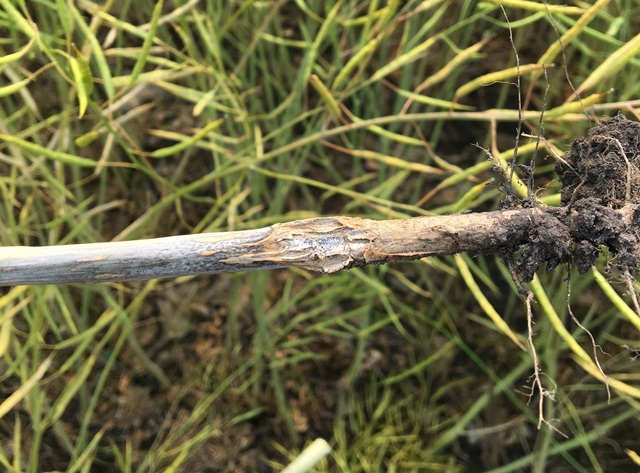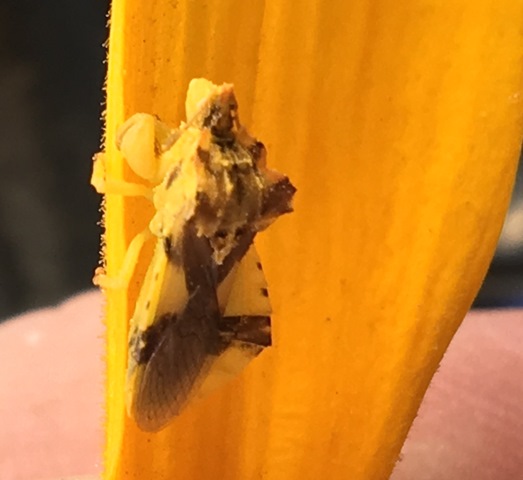Manitoba Insect & Disease Update
Issue 11: August 8, 2018
Summary
Diseases: Additional clubroot cases confirmed in the province. Disease surveys in canola fields are being conducted across the province.
Insects: Soybean aphids were reported, at very low levels, for the first time this year. Given their very late arrival, low levels, and the advancement of the soybean crop, the risk of them being at economical levels in fields in Manitoba this year is very light.
Bertha armyworm continues to be found in canola fields in western Manitoba, but there have only been a few fields where it was reported at economic levels.
Clubroot
Symptoms of clubroot in canola have been confirmed in a number of additional fields, bringing the total number of "new" (not previously reported to Manitoba Agriculture) fields in 2018 to eight. Six of these fields are in the RM of Pembina, one in the RM of Lorne, and one in RM of Dufferin. An updated clubroot map can be found here. Many of these new reports are due to the increasing awareness of the disease by growers in areas where it has been previously reported. It is recommended that growers investigate any patches where canola is underperforming, especially areas that may typically do poorer like field entrances and low-lying areas of the field.
Canola Disease Survey
Canola around the province is being surveyed for all diseases by Manitoba Agriculture, Agriculture and Agri-Food Canada, and Canola Council of Canada staff. The fields are typically surveyed just prior to swathing or desiccating, so a number of fields in southern Manitoba have been surveyed already or will be surveyed in the new few days. Reports of sclerotinia in this area are very low and blackleg levels vary from field to field. Some fields are showing blackleg levels as high as 80% of plants affected. Fields that suffered from hail or insect damage during the season are more susceptible to blackleg infection.

Figure 1. Blackleg symptoms in canola observed during the 2018 Canola Disease Survey.
Late-season flea beetles in Canola
Some have been asking about the impact of flea beetles on canola this time of year. A study was done at Agriculture and Agri-Food Canada in Saskatoon to determine how economical these late-season populations they could be. The study concluded that:
Flea beetle feeding on canola in late-summer is rarely an economic concern. Flea beetle feeding that occurs when seeds in lower pods of canola are at the green stage or beyond is unlikely to affect seed yields regardless of the infestation rate of flea beetles. Even when seeds are translucent to green, numbers higher than 100 flea beetles per plant, and for some cultivars higher than 350 per plant, may be necessary to cause significant yield reductions (Soroka and Grenkow. Can. J. Plant Sci. 2012: 97-107).
Flea beetle feeding on canola in late-summer is rarely an economic concern. Flea beetle feeding that occurs when seeds in lower pods of canola are at the green stage or beyond is unlikely to affect seed yields regardless of the infestation rate of flea beetles. Even when seeds are translucent to green, numbers higher than 100 flea beetles per plant, and for some cultivars higher than 350 per plant, may be necessary to cause significant yield reductions (Soroka and Grenkow. Can. J. Plant Sci. 2012: 97-107).
So in most instances controlling these late-season flea beetle populations is not going to be economical.
Defoliators in Canola
At this time of year, there are potentially a few defoliating insects that can be present in canola. And sometimes making management decisions can be tricky because of multiple factors at play.
Melting bertha armyworm: A couple of agronomists from southwest Manitoba have recently mentioned that they were seeing bertha armyworm up on the plants in the middle of the day, and the caterpillars looked as though they were melting. This is likely a virus in the population in the area. Although the caterpillars would have done some feeding already, pathogens like this can help lower populations for the next year.
Decision making when multiple species are involved: Where decision making can get very tough is when multiple species are feeding on the crop, with none above an economic threshold, but visible feeding occurring. In some fields that have below threshold levels of bertha armyworm some grasshoppers have moved in as well. Both may feed on the pods. So keep an eye on the level of pod feeding.
There may be an edge effect for the grasshoppers. Don't assume levels seen during your first few steps in the field are the same throughout the field. Canola is not a preferred food for grasshoppers, and there is often an edge effect as they move in from other preferred plants. A nominal threshold for grasshoppers that can be used in canola is about 7 to 12 per square meter, but do consider how far they have moved into the field, and what else is happening in the field.
Preharvest Intevals: If the canola is within a week of swathing, there is only 1 insecticide that can be used for defoliators such as grasshoppers and bertha armyworm. That is Coragen, with a 1 day preharvest interval. If it will be over a week until swathing there are several options with a 7 day preharvest interval (see the Guide to Field Crop Protection for details).
Insect Monitoring Programs
Grasshopper Survey: A reminder for those participating in the grasshopper survey, that counts are done during August, when the majority of grasshoppers are in the adult stage. Even if grasshopper levels are low in your area, this is valuable data for the survey. So don't not do counts in a region because grasshopper levels are low. The purpose of the survey is to map what average grasshopper levels are like in a region.
Agronomists and farmers who would also be interested in estimating grasshopper numbers in or around the fields they are in and have this information included in the survey are encouraged to see the survey protocol for more details of the survey and where to send data. Estimates of grasshopper levels can be collected during regular farm visits. Data from the survey, along with weather data during the egg laying period of the grasshoppers, is used to produce a forecast for 2018.
The protocol and data sheet for the grasshopper survey is at: http://www.gov.mb.ca/agriculture/crops/insects/mb-grasshopper-survey.html
The protocol and data sheet for the grasshopper survey is at: http://www.gov.mb.ca/agriculture/crops/insects/mb-grasshopper-survey.html
Insect Identification Quiz
This insect was found in sunflowers. What is it? Does it feed on sunflowers?

Photo by Troy Turner, Field 2 Field Agronomy
Answer: This is a species of ambush bug.
They are predators and sit and wait for prey to come to them, relying on their superb camouflage. Ambush bugs have thickened forelegs, shaped somewhat like those of praying mantises. They routinely capture prey ten or more times their own size. Note how the rear half of the abdomen is expanded (much wider than wings).
Ambush bugs are cousins of assassin bugs and taxonomically are a subgroup (Phymatinae) within the assassin bugs. They can be especially common on goldenrod late in the season.
----------------------------------------------------------------------------------------------------------------------
Compiled by:
John Gavloski, Entomologist Holly Derksen, Field Crop Pathologist
Manitoba Agriculture Manitoba Agriculture
Phone: (204) 750-0594 Phone: (204) 750-4248
To report observations on insects or plant pathogens that may be of interest or importance to farmers and agronomists in Manitoba, please send messages to the above contacts.
To be placed on an E-mail list so you will be notified immediately when new Manitoba Insect and Disease Updates are posted, please contact John Gavloski at the address or numbers listed above.
